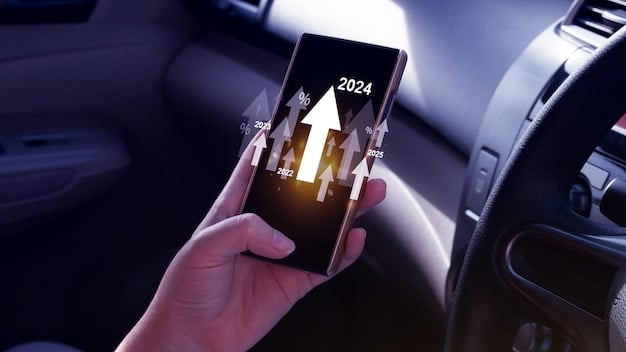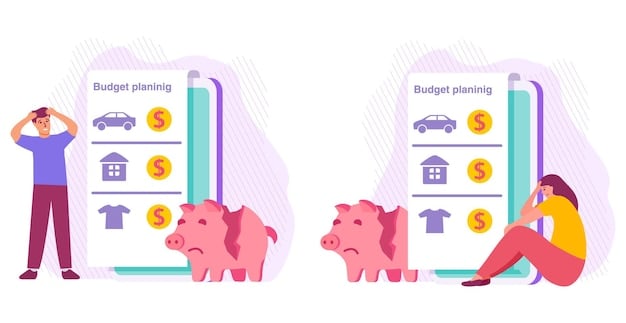Auto Subscriptions: Will 20% of US Car Owners Subscribe by 2026?

The rise of subscription services in the auto industry is transforming how Americans access vehicles, offering flexibility and convenience that could lead to 20% of US car owners subscribing by 2026.
The automotive industry is undergoing a significant shift, moving away from traditional ownership models toward subscription-based services. The question is: can the rise of subscription services in the auto industry truly capture a significant share of the US market, potentially seeing 20% of car owners subscribe by 2026?
The Allure of Auto Subscription Services
Auto subscription services offer an alternative to traditional car ownership, combining elements of leasing and renting into a single, convenient package. This model aims to attract consumers seeking flexibility and hassle-free access to vehicles.
Benefits for Consumers
For many, the appeal lies in the ability to switch between different car models based on their needs, whether it’s an SUV for a family trip or a compact car for city commuting. This flexibility can be a major draw.
Simplicity and Inclusivity
Subscription services typically bundle insurance, maintenance, and roadside assistance into a single monthly payment, simplifying budgeting and eliminating unexpected expenses. This all-inclusive approach can be particularly attractive to those who dislike the complexities of car ownership.
- Flexibility: Switch between vehicle types as needed.
- Convenience: All-inclusive monthly payment covers most car-related expenses.
- Reduced Commitment: Avoid long-term contracts and depreciation concerns.
However, the subscription model is not without its challenges. Cost can be a significant barrier, as subscription fees may be higher than traditional car payments, especially for budget-conscious consumers. Availability is another factor, as these services are not yet widespread and may be limited to certain geographic areas or vehicle types.
In conclusion, the allure of auto subscription services lies in their promise of flexibility and convenience, but their success hinges on addressing cost concerns and expanding availability.

Market Trends Shaping Auto Subscriptions
Several key market trends are influencing the growth and adoption of auto subscription services. Understanding these trends is crucial for assessing the likelihood of achieving a 20% subscription rate by 2026.
Changing Consumer Preferences
Consumer preferences are shifting, particularly among younger generations, who prioritize access and experiences over ownership. This trend favors subscription models that offer flexibility and convenience without the long-term commitment of buying a car.
Technological Advancements
Advancements in technology, such as connected car platforms and mobile apps, are making it easier to manage and deliver subscription services. These technologies enable seamless vehicle access, personalized user experiences, and efficient fleet management.
- Digitalization: Mobile apps and connected car technologies enhance user experience.
- Data Analytics: Insights into driving behavior and preferences enable service personalization.
- Evolving Mobility Needs: Urbanization and changing commuting patterns drive demand for flexible transportation solutions.
However, regulatory hurdles and infrastructure limitations could hinder the growth of auto subscription services. Varying state regulations regarding insurance and vehicle registration create complexities for providers. Furthermore, limited charging infrastructure for electric vehicles may discourage adoption, especially in areas with low charger availability.
In summary, evolving consumer preferences and technological advancements are driving the growth of auto subscriptions, but regulatory and infrastructure challenges need to be addressed for widespread adoption.
Economic Factors Influencing Subscription Adoption
Economic factors play a pivotal role in determining the affordability and attractiveness of auto subscription services. These factors include consumer income, interest rates, and the overall economic climate.
Impact of Economic Conditions
During periods of economic prosperity, consumers are more likely to spend on non-essential services like auto subscriptions. Conversely, economic downturns may lead consumers to prioritize cost savings and postpone discretionary spending.
Interest Rates and Financing
The cost of traditional car ownership is heavily influenced by interest rates, which affect the affordability of auto loans. Rising interest rates can make subscription services more appealing, as they offer a fixed monthly payment without the need for financing.

- Affordability: Subscription costs compared to traditional car ownership expenses.
- Economic Stability: Consumer confidence and spending habits impact subscription uptake.
- Interest Rates: Higher rates increase the attractiveness of fixed-payment subscription models.
However, the relatively high cost of subscription fees compared to traditional car ownership remains a significant barrier for many consumers. While subscription services offer convenience and flexibility, their premium pricing may deter budget-conscious individuals. Additionally, the lack of long-term asset ownership may not appeal to those who value building equity through car ownership.
In conclusion, economic conditions and interest rates significantly impact the adoption of auto subscription services, but the high cost and lack of asset ownership may limit their appeal to a broader audience.
Challenges and Opportunities for Subscription Providers
Auto subscription providers face a unique set of challenges and opportunities in the evolving automotive landscape. Overcoming these hurdles and capitalizing on emerging trends is crucial for their long-term success.
Operational Complexities
Managing a fleet of vehicles and ensuring their maintenance, insurance, and availability can be operationally complex. Providers need to invest in robust logistics and technology solutions to streamline these processes.
Pricing Strategies
Determining the right pricing strategy is essential for attracting customers while maintaining profitability. Providers need to balance the value proposition of flexibility and convenience with the cost sensitivity of consumers.
One key opportunity lies in partnerships with automakers, technology companies, and insurance providers. Collaborations can help subscription providers access vehicle inventory, develop innovative technology platforms, and offer competitive insurance rates. Furthermore, expanding service offerings, such as concierge services and personalized vehicle customization, can enhance the overall customer experience and differentiate providers from competitors.
However, competition from traditional car rental companies and emerging mobility services poses a threat to subscription providers. These established players may offer similar services at lower prices, leveraging their existing infrastructure and brand recognition. Additionally, changing consumer preferences and technological disruptions could rapidly alter the competitive landscape, requiring providers to adapt and innovate continuously.
In summary, auto subscription providers face both operational challenges and competitive threats, but strategic partnerships and service innovation can help them capitalize on the growing demand for flexible mobility solutions.
Consumer Perceptions and Acceptance
Consumer perceptions and acceptance are critical factors influencing the uptake of auto subscription services. Understanding what drives consumer interest and addressing their concerns is essential for widespread adoption.
Trust and Transparency
Building trust and ensuring transparency in pricing and terms of service are crucial for gaining consumer confidence. Subscription providers need to clearly communicate the benefits and limitations of their services.
Awareness and Education
Many consumers are still unfamiliar with the concept of auto subscriptions. Raising awareness and educating potential customers about the advantages of this model is essential for driving adoption.
- User Experience: Simplifying the subscription process and providing excellent customer support.
- Value Proposition: Clearly communicating the benefits of flexibility, convenience, and cost savings.
- Customization: Offering personalized subscription plans to meet individual needs and preferences.
However, negative perceptions related to cost, limited vehicle selection, and lack of asset ownership can hinder consumer acceptance. Addressing these concerns through competitive pricing, diverse vehicle options, and flexible subscription terms is essential for overcoming resistance. Additionally, leveraging social media and online reviews can help build trust and credibility among potential customers.
In conclusion, positive consumer perceptions and acceptance are vital for the success of auto subscription services, and addressing concerns related to cost, vehicle selection, and ownership is crucial for driving widespread adoption.
Forecasting the Future: Will 20% Subscribe by 2026?
Predicting whether 20% of US car owners will subscribe to auto services by 2026 requires a careful assessment of current trends, future projections, and potential disruptors. While the subscription model offers numerous benefits, several challenges remain.
Current Adoption Rates
Current adoption rates for auto subscription services are still relatively low, with only a small percentage of US car owners currently subscribing. Achieving a 20% subscription rate by 2026 would require significant growth and widespread acceptance. Reaching this goal depends on several factors aligning favorably, including continued economic growth, technological advancements, and positive shifts in consumer preferences.
Achieving 20% penetration by 2026 would be ambitious but not entirely impossible, especially if subscription providers can address key barriers to adoption, such as high costs and limited availability. Innovations in pricing models, expansion of service areas, and partnerships with automakers could accelerate growth. However, unforeseen economic downturns, regulatory challenges, or technological disruptions could also derail these efforts.
In summary, while the rise of subscription services in the auto industry is promising, achieving a 20% subscription rate among US car owners by 2026 depends on overcoming existing challenges and capitalizing on emerging opportunities. The future of auto subscriptions will be shaped by a complex interplay of economic, technological, and consumer-driven factors.
| Key Point | Brief Description |
|---|---|
| 🚗 Flexibility | Switch vehicle types as needed, adapting to different situations. |
| 💰 Cost | All-inclusive monthly fees versus traditional ownership costs. |
| 📈 Market Trends | Changing consumer preferences and technological advancements. |
| 🎯 Adoption Rate | Forecasting if 20% US car owners will subscribe by 2026. |
FAQ
▼
Auto subscription services offer access to vehicles for a monthly fee, covering insurance, maintenance, and roadside assistance, providing a flexible alternative to traditional car ownership.
▼
The primary benefits include flexibility to switch vehicles, convenience of all-inclusive payments, and reduced commitment compared to buying or leasing a car.
▼
Economic factors such as consumer income, interest rates, and overall economic stability play a crucial role in determining the affordability and attractiveness of auto subscriptions.
▼
Subscription providers face operational complexities in managing fleets, competition from traditional rental companies, and the need to establish competitive pricing strategies.
▼
Consumer perceptions are shaped by trust, transparency, and awareness. Addressing concerns about cost and vehicle selection is essential for driving wider acceptance.
Conclusion
In conclusion, the auto industry is at a pivotal moment with the rise of subscription services, offering a unique blend of flexibility and convenience. Whether 20% of US car owners will subscribe by 2026 remains uncertain, but the trends suggest a growing interest in these alternative ownership models, and it will be interesting to see it play out.





